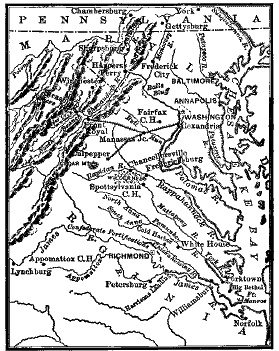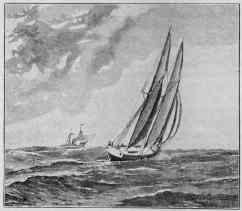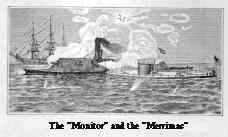Resource Center OLLibrary
|
286 |
|
[1861 |
selling its cotton or from raising money in any way. The
national government obtained it in four ways:
1. By calling on the people of the North for
many kinds of new taxes.
2. By a war tariff which increased the duties
collected on imported goods, and compelled payment of such duties
in gold.
3. By issuing enormous quantities of paper
money, commonly called "greenbacks."
4. Finally, and chiefly, by borrowing hundreds
of millions of dollars both at home and abroad. In return for
these loans the national government gave bonds which promised to
repay the borrowed money in a certain number of years, and to pay
interest on it at from six to over seven per cent per year.
In order to obtain these loans more readily, the
government created (1863) a great system of new banks called
National Banks. The state and city banks then in existence (§
265) had this disadvantage: their paper money often would not pass
in another state except at a loss to the holder. On this account
people frequently could not tell, when away from home, what a
dollar bill was really worth. But the national-bank bills have
always been good all over the United States, because the banks
which issue them are obliged by law to deposit government bonds
with the treasurer at Washington as security.1 The
National Banks increased rapidly; they are now the only ones which
issue paper money (§ 440).
325. The Number and Position of the Two
Armies. President Lincoln's first call for troops was quickly
followed by others, and the South likewise strengthened its side.
By the summer of 1861 the Union forces probably numbered about
180,000, and those of the Confederates 150,000. The former were
under the direction of the veteran General Scott (§ 292), and
the latter under General Beauregard.2 The Union army
was mainly in eastern Virginia and
1 By the act of 1863
(materially changed in 1900), National Banks were compelled to
borrow money from the national government, to the amount of 90
percent of the bills they issued, and to deposit the bonds they
received from the government with the treasurer at Washington.
2 General Joseph E. Johnston ranked
above General Beauregard, and after the battle of Bull Run (July
21, 1861), in which he took a leading part, he held command of the
Confederate army of Virginia until he was wounded at the battle of
Seven Pines, May 31, 1862, when General Lee took
command.
|
1861] |
|
287 |
Maryland. It extended along the banks of the Potomac from
Harpers Ferry to the mouth of the river, and thence southward to
Fort Monroe. The Confederate army held the country south of the
Potomac, with Richmond as its fortified center. (Map, p. 284.)
In Missouri the national troops, under General
Lyon, Frémont,1 and Halleck, got control of that
state, while General McClellan drove the Confederates from West
Virginia. In the southwest the Confederates had got possession of
the Mississippi from New Orleans to Columbus, Kentucky, by
building forts on the banks of the river. They were preparing to
do the same on the Tennessee and Cumberland rivers and they hoped
to get the entire control of Kentucky besides.
326. The Battle of Bull Run. The cry at
the South was, "On to Washington!" It was answered by the cry of
the North, "On to Richmond!" Beauregard had taken up his position
at Manassas junction on a small stream called Bull Run. There he
could both protect the Confederate capital and threaten
Washington. He had an army of about 30,000. General McDowell, in
command, in the field, of the Union forces, had about the same
number.2 One army, as President Lincoln said, was as
"green" as the other. McDowell advanced, not because he was ready,
but for the simple reason that the North was tired of waiting and
was impatient to strike a decisive blow.
The battle began on a sweltering hot Sunday in
July (July 21, 1861). At first the Union troops drove the
Confederates from their position. General Bee, one of the Southern
leaders, rushing
I General
Frémont was born at Savannah in 1813. Under the authority
of the government he began the exploration of the Rocky Mountains
and of an overland route to the Pacific in 1842-1844, In 1845 he
set out on another exploring expedition to the Pacific coast.
After the outbreak of the Mexican War he, with the assistance of
American settlers in California, freed that territory from the
authority of Mexico, and in the summer of 1846 he was appointed
governor of the territory. The treaty of peace (1848) secured
California to the United States. In 1856 Frémont was
nominated to the presidency (as the Anti-Slavery candidate) by the
Republican party. From 1878 to 1881 he was governor of Arizona. In
the summer of 1861 Fremont issued a proclamation emancipating the
slaves of all persons in Missouri who were in arms against the
Union; but President Lincoln refused to approve it.
2 In the Civil War the Confederates
counted in battle only those of their men who were present and
able to fight; but the Union officers, on the contrary, counted
all as present whose names were on their army rolls. See General
Grant's "Personal Memoirs," II, 290, and "The Century Company's
War Book," I, 485.
|
288 |
|
[1861 |
|
up to General Jackson, cried out, "General, they. are
beating us back!" "We will give them the |
|
1861] |
|
289 |
The cry of the North was now, "Drill and
organize!" General McClellan came from West Virginia (§ 325)
to take command of the army. He taught the men the great lesson,
that enthusiasm without military organization is of no more use
than steam without an engine. For the next six months and more
"all was quiet on the Potomac";1 that quiet, however,
meant that both sides were getting ready to fight in terrible
earnest.
328. Union Plan of the War. Gradually a
plan for the war in defense of the Union took shape; it was
this:
1. To station vessels of war in front of all
Southern ports (Map, p. 286), and thus cut off the South from
getting supplies from abroad for carrying on the contest. This
blockade by the Union navy was of immense help, and without it the
contest might have dragged on for many years longer than it
did.
2. To attack and take Richmond.
3. To open the lower Mississippi, with the
Tennessee and the Cumberland, which the Confederate forts had
closed to navigation.
4. To break through the Confederate line in the
West, march an army to the Atlantic, and thence northward to
Virginia.
329. Blockade Runners; Confederate War
Vessels; Seizure of Mason and Slidell. While the Union forces
were getting possession of Fort Hatteras, Port Royal, and other
points on the coast of North and South Carolina, fast Southern
vessels ran the gantlet of the blockade to obtain arms and
ammunition; furthermore, British steamers, specially built for the
work, often succeeded in evading the Union cruisers and in
bringing supplies for the Confederates. Jefferson Davis had no
navy, but he succeeded in buying or building a number of war
vessels in Great Britain, which in time destroyed so many merchant
ships owned in the North that unarmed vessels no longer dared to
carry the Stars and Stripes. Later, the Alabama, built in
England, was added to the Confederate fleet and inflicted immense
damage on Union commerce, for which at the end of the war England
had to pay roundly (§ 374).
1 On October 21,
1861, a body of Union troops, 2000 strong, was beaten by a large
force of Confederates at Ball's Bluff on the Potomac, and on
August 10 of the same year General Lyon was defeated and killed at
the battle of Wilson's Creek, Missouri.
|
290 |
|
[1861 |
Early in November (1861) the Confederacy
undertook to send two commissioners or agents -- Mason and Slidell
-- to Europe to get aid for the Southern cause and also to
endeavor to persuade England and France to acknowledge the
Independence of the Confederate States.
Captain Wilkes of the United States navy stopped
the British mail steamer Trent, on which Mason and Slidell had
embarked for England, and took them both prisoners. England at
once
 bayonet,"
said Jackson, quietly rallying his men, Bee shouted,
Look! there is Jackson standing like a stone wall!" It
was true and "Stonewall" Jackson,1 as the
Confederate general was ever after called, used "the
bayonet" to check the Union advance. Then the Southerners
held their ground until heavy reënforcements came
up, by rail, from the Shenandoah valley, and drove the
Union troops from the hard-fought field. As the
Confederate General J. E. Johnston says: "The Northern
army fought under the great disadvantage of having to
make the attack. They fled back to Washington in
confusion."
bayonet,"
said Jackson, quietly rallying his men, Bee shouted,
Look! there is Jackson standing like a stone wall!" It
was true and "Stonewall" Jackson,1 as the
Confederate general was ever after called, used "the
bayonet" to check the Union advance. Then the Southerners
held their ground until heavy reënforcements came
up, by rail, from the Shenandoah valley, and drove the
Union troops from the hard-fought field. As the
Confederate General J. E. Johnston says: "The Northern
army fought under the great disadvantage of having to
make the attack. They fled back to Washington in
confusion."
 288.)
The Union ships were of wood, and the balls from their
guns could no more penetrate the iron shell of the
monster which now attacked them than a sparrow's bill
could penetrate the back of an alligator. The
Merrimac sunk the Cumberland, which carried
down with her many sick and wounded men;1 she
then destroyed the Congress. The next day (Sunday,
March 9, 1862) the Merrimac returned to complete
the destruction of the fleet; suddenly a strange little
craft appeared, looking like a "cheese box on a raft."
This was the Monitor,2 new Union war
vessel built of iron and commanded by Lieutenant Worden.
The Merrimac now found that she had got her match.
After a terrific battle the Confederate vessel hurried
back to Norfolk.
288.)
The Union ships were of wood, and the balls from their
guns could no more penetrate the iron shell of the
monster which now attacked them than a sparrow's bill
could penetrate the back of an alligator. The
Merrimac sunk the Cumberland, which carried
down with her many sick and wounded men;1 she
then destroyed the Congress. The next day (Sunday,
March 9, 1862) the Merrimac returned to complete
the destruction of the fleet; suddenly a strange little
craft appeared, looking like a "cheese box on a raft."
This was the Monitor,2 new Union war
vessel built of iron and commanded by Lieutenant Worden.
The Merrimac now found that she had got her match.
After a terrific battle the Confederate vessel hurried
back to Norfolk.


